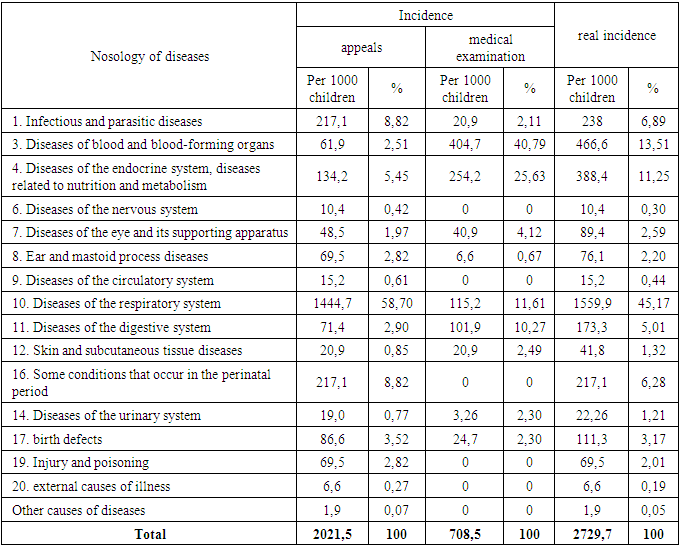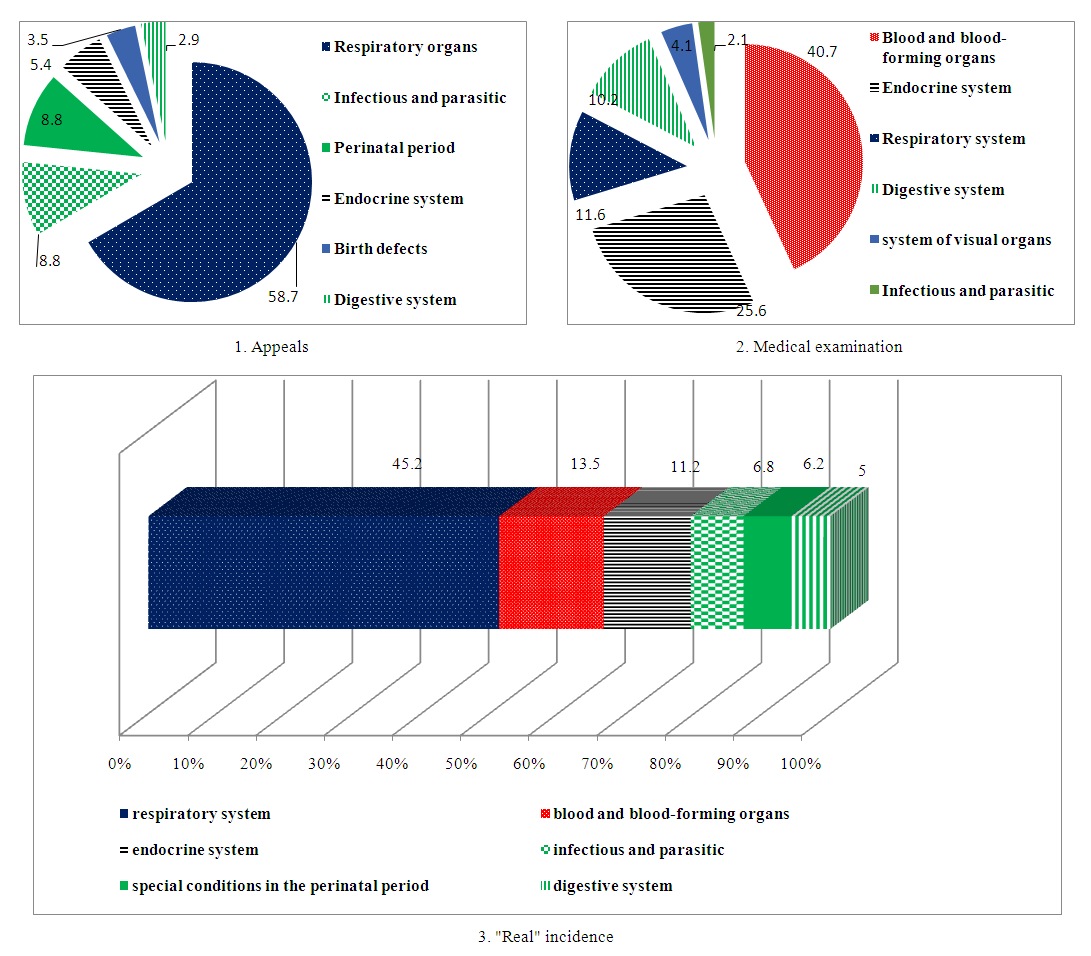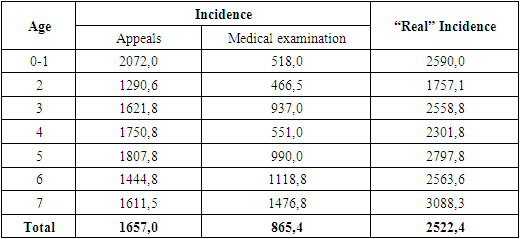Bakhrom M. Mamatkulov1, Ikromjon Otajonov2
1School of Public Health, Tashkent Medical Academy, Tashkent, Uzbekistan
2Department of General Hygiene, Andijan State Medical Institute, Andijan, Uzbekistan
Correspondence to: Bakhrom M. Mamatkulov, School of Public Health, Tashkent Medical Academy, Tashkent, Uzbekistan.
| Email: |  |
Copyright © 2023 The Author(s). Published by Scientific & Academic Publishing.
This work is licensed under the Creative Commons Attribution International License (CC BY).
http://creativecommons.org/licenses/by/4.0/

Abstract
In order to plan medical care for children, it is important to determine and analyze the incidence rates of certain children's diseases, in addition to the general incidence rates. In-depth study of urban and rural children's illness reveals some specific age-related characteristics of children, which in turn makes it possible to develop complex systematic preventive measures for children's health and conduct treatment activities, as well as their practical application.
Keywords:
Real disease, FP (family polyclinic), FMC (family medical center), Medical examination, Children's diseases
Cite this paper: Bakhrom M. Mamatkulov, Ikromjon Otajonov, Specific Features of the Disease of Children Living in the City and the Village (on the Example of the Andijan Region), American Journal of Medicine and Medical Sciences, Vol. 13 No. 4, 2023, pp. 525-529. doi: 10.5923/j.ajmms.20231304.37.
1. Introduction
Maintaining and strengthening children's health is one of the urgent tasks of the health care system. Children's health status is the most important criterion for assessing the well-being of society, one of the factors of the country's national security [1,2,3,4,5,6,10,12,13].According to some authors, when studying diseases based on referrals in primary medical institutions, this indicator is a maximum of 3016.5‰ for every 1000 children of this age among children under the age of one year, and relatively low in the second and third years is 2655.4‰. [3]. According to other authors, the morbidity rate of children under one year in rural conditions ranges from 2001.1‰ to 4470.8‰, and it is higher than the incidence rate of urban children [4,8,7,11,14]. According to the researchers, the objective data obtained on the morbidity of the children's population is the basis for the development of regional targeted programs based on the principles of prevention and the priority of medical and social direction. In addition, it ensures the targeted orientation of the medical care provided to them, close cooperation and active participation of various services and departments [9].In order to plan medical care for children, in addition to the general incidence rates, the incidence rates and their analysis of certain children's diseases are important. Each region has its own diseases and the level of morbidity, which must be taken into account when developing treatment and preventive measures aimed at maintaining and improving the health of children in this region.Therefore, in modern conditions, it is appropriate to consider children's health as a guarantee of state development and a factor of national security.
2. Aim
Comparative analysis and evaluation of diseases among children under 7 years of age living in rural and urban areas.
3. Materials and Methods
1050 children born in Andijan in 2019 were selected. For this purpose, the 1st, 2nd, 6th, 8th polyclinics in Andijan city used the "bird's nest - nest selection" method, and 1050 children (530 boys and 520 girls) who turned 3 in 2019 were attached to them, from birth to 7 studied prospectively by monitoring health in dynamics up to age (cohort research method). 1050 children (510 boys and 540 girls) who turned 3 years old in 2019 from Asaka and Baliqchi districts and their attached village family polyclinics (FP) were taken to study the incidence of rural children under the age of 7. Asaka district 5-, 6-, 7-, 12- the family polyclinic and ChEK and Chorbogh FMC (family medical center), as well as the 14th, 16th, 18th FP, Sheralichek, Tumor and Navoiy FMC from Balikchi district were selected.
4. Results and Discussion
According to the results of the research, "real" diseases among Andijan children under the age of 7 include diseases of the respiratory system (45.1%), diseases of the blood and blood-forming organs (13.5%), diseases of the endocrine system (11, 2%), infectious and parasitic diseases (6.8%), and diseases of the digestive organs (5.0%) occupy the leading positions (Table 1). These diseases accounted for 84.9% of children diseases under 7 years of age (Figure 1). Special attention to these 6 classes of diseases in the development of measures aimed at the prevention of diseases among children will lead to a reduction of 80% of diseases among children.Table 1. The incidence rate and structure of children according to the nosology of diseases
 |
| |
|
 | Figure 1. Andijan city the structure of children under 7 years of age (%) |
When we analyzed the diseases of children identified as a result of medical examinations and referrals, the following diseases took the leading place.In the structure of diseases based on appeals, diseases of respiratory organs took the lead and occupied 58.1%. The second place is taken by special conditions in the perinatal period (8.8%) and infectious and parasitic diseases (8.8%), the third place is endocrine system diseases (5.4%), the fourth place is birth defects (3.5%) and the fifth place diseases of the digestive system (2.9%). 88.1% of all diseases of children under 7 years of age corresponded to these 6 classes of diseases. Diseases of blood and blood-forming organs accounted for 40.1% of the diseases detected during medical examinations, diseases of the endocrine system (25.6%), diseases of the respiratory system (11.6%), diseases of the digestive system (10.2%), diseases of the eye and its supporting apparatus (4.1%), and infectious and parasitic diseases (2.1%). 94.3% of the diseases detected in all medical examinations corresponded to these 6 classes of diseases.In the Baliqchi and Asaka districts of Andijan region, when the incidence of children under 7 years of age was studied based on appeals, it was noted that the highest incidence rate corresponded to one year old (20.72 per 1000 children of this age group). When the incidence rate of rural children under 7 years old is analyzed by youngs, it is 1290.6 in 2 years old compared to 1000 children in this age group; 1621.8 in 3 years; 1750.8 at the age of 4; 1807.8 at the age of 5; 1444.8 at the age of 6; At the age of 7, it was 1611.5 (Table 2).Table 2. Age-specific characteristics of morbidity in rural children under seven years of age (per 1000 children in this age group)
 |
| |
|
As a result of the conducted medical examinations, the incidence rate for 1000 children of this age is 518.0 at the age of 1; 466.6 in 2 years; 937.0 at the age of 3; 551.0 at the age of 4; 990.0 at the age of 5; It was found to be 1118.8 at the age of 6, and 1476.8 at the age of 7. The "real" incidence rate of rural children of Andijan region is 2590.0 in age 1 per 1000 children of this age; 1757.1 in age 2 ; 2558.8 at the age of 3; 2301.8 at the age of 3; 2797.8 at the age of 5; It was 2563.6 at the age of 6 and 3088.3 at the age of 7. The incidence rate of rural children of Andijan region based on appeals is 1657.0 on average in 7 years, the incidence rate obtained as a result of medical examination is 865.4, and the actual incidence rate is 2522.4. Also, as a result of medical examinations, it was found that the average "real" incidence rate of rural children under 7 years old is 63.6% (Fig. 2). | Figure 2. Incidence of children under 7 years of age (per 1000 children of this age group) |
Table 3 shows that in the first year of children's life, 25% of diseases were detected as a result of medical examinations, and from the age of 2, the percentage of diseases detected during medical examinations increased, at the age of 2, 43.6%, at the age of 3, 69.6%, at the age of 4, 37,6%, 67.6% at 5 years old, 116.2% at 6 years old and 114.8% at 7 years old. These data show that the importance of regular periodic medical examinations among rural children is relevant, including the organization and conducting of medical examinations, which are of great importance in identifying and preventing chronic diseases in the children's body. Table 3. Percentage of diseases detected in medical examinations (%)
 |
| |
|
Anemia among the diseases of the blood and blood production system among rural children was higher than that of urban children. This disease 25.7‰ at the age of 2, 53.3‰ at the age of 3; 43.8‰ at the age of 4; 79.0 ‰ at the age of 5; 145.7‰ at the age of 6; At 7 years it was 172.4 ‰, and it was found that the incidence rate at 7 years increased by 7 times compared to 1 age. Mostly mild and moderate forms of anemia were noted in village children. Anemia in children is a sign of poor nutrition. Among rural children, after two years of age, compared to urban children, the incidence of injuries and accidents is slightly higher than in the first year of life, and it is manifested in more cases of superficial injuries. In the morbidity structure of rural children, isolated cases in the perinatal period took the fifth place (7.6%) in the number of morbidity in the first year of children, and it was 257.1‰ at the age of 1 (only due to the incidence of children of the first age).In its structure, perinatal injury of the CNS prevailed in the cases studied on the basis of children's appeals, while it was not detected at all during the in-depth medical examination of children. Thus, Andijan region made a deep study of the diseases of urban and rural children under the age of seven, identified some specific age-related characteristics of urban and rural children, which, in turn, allows to improve the measures developed for the health and treatment of children.
5. Conclusions
1. In the structure of "real" diseases of Andijan city children under of 7 years of age diseases of respiratory organs, diseases of blood and blood-forming organs, diseases of the endocrine system, infectious and parasitic diseases and diseases of digestive organs the leading places and these diseases are 84,9% of the general diseases.2. Anemia (anemia) from blood and blood production system diseases among rural children is higher than that of urban children.3. In the 1st year of children's life 25% of diseases are detected as a result of medical examinations and as the age of the child increases they are detected during medical examinations the percentage of diseases is increasing.
References
| [1] | Авезова Г.С. Уч ёшгача болалар саломатлиги шаклланишининг тиббий –ижтимоий қирралари // Тиб. ф.н. дисс. автореферати, Тошкент-2012, 24 бет. |
| [2] | Авезова Г.С., Исраилова Х.Ю. Особенности заболеваемости детей первого года жизни в городе Ташкенте. European research 2017; 2(25): 101-102. |
| [3] | Каримов У.А. Ўзбекистон шароитида кичик ёшли болалар касалликларини мажмуавий баҳолаш ва тиббий хизматни такомиллаштириш // Дисс.окд.мед.наук. – Ташкент, 1994. – 311с. |
| [4] | Каюмов Х.Н. Қишлоқ шароитида яшовчи етти ёшгача бўлган болаларнинг нафас олиш аъзолари касаллкилари билан касалланиш кўрсаткичлари // Педиатрия –Тошкент. -1999. -№1, 25-27 б. |
| [5] | Кобринский, Б.А. Современные информационные технологии в системе охраны здоровья детей // Вестник Национального комитета «Интеллектуальные ресурсы России». - 2006. - № 4. - С. 91-93. |
| [6] | Меланичева Т.Г., Агафонова Е.В., Зиатдинова Н.В., Скидан И.Н. Влияние характера вскармливания детей первого года жизни на формирование резистентности организма. Российский вестник перинатологии и педиатрии 2020; 6(65): 145-154. |
| [7] | Мещеряков В.В. Заболеваемость и смертность детей в сельской местности // Пробл. соц. гиг. здравоохр. и истории медицины. - Москва, 2007. - № 1. -С.14-17. |
| [8] | Маматкулов Б. Медико –социальные аспекты формирования, охраны и улучшения здоровья детей первых 7 лет жизни // Дис. … Д-ра мед. наук. – Ташкент, 1997. – 334с. |
| [9] | Савина, Л.Н. К вопросу о состоянии здоровья современных российских школьников // Известие Пензенского государственного педиатрического универ¬ситета им. В.Г. Белинского. - 2009. - № 18. - С. 88-91. |
| [10] | Садыков М.М. Основные тенденции состояния здоровья детского населения Казани // Росс. педиатрический журнал - М., 2007. – N6. - C. 45-48. |
| [11] | Турымбетова М.Т. Состояние здоровья детей первого года жизни в Республики Каракалпакстан // Педиатрия. -Ташкент, 2002. -№2. -С. 10-12. |
| [12] | Яковлева, Т.В. Состояние здоровья детей дошкольного возраста из бедных семей / Е.А. Курмаева, С.Я. Волгина. - Вопросы современной педиатрии. - 2008. - Т. 7, № 4. - С. 14-18. |
| [13] | Shaikh BT, Haran D. Treating common illnesses among children under five years: a portrayal of health-seeking behaviours and practices in the northern areas of Pakistan. // World Health Popul. 2011; 12(4): 24-34. |
| [14] | Yi B, Wu L, Liu H. at all. Rural-urban differences of neonatal mortality in a poorly developed province of China. // BMC Public Health. 2011 Jun 18; 11: 477. |





 Abstract
Abstract Reference
Reference Full-Text PDF
Full-Text PDF Full-text HTML
Full-text HTML

